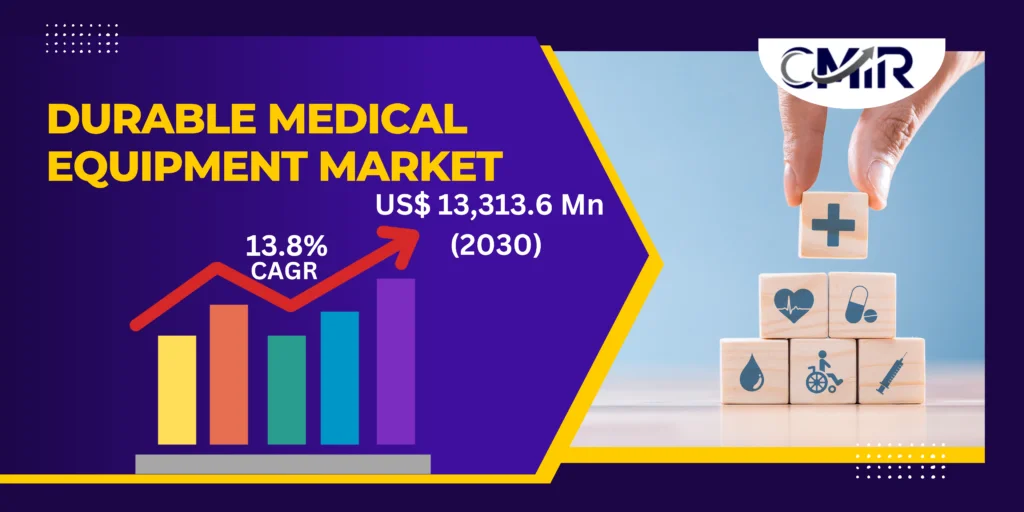-Advertisement=
Durable medical equipment (DME) refers to medical equipment that is prescribed by a healthcare provider for use in a patient’s home, and is intended for long-term use (at least three years). DME can include a wide range of items, such as wheelchairs, walkers, hospital beds, oxygen tanks, nebulizers, and prosthetic limbs.
DME is typically prescribed for patients with chronic conditions, disabilities, or injuries that require ongoing medical care and support. The equipment is designed to provide comfort, mobility, and independence to patients in their daily lives, and is often covered by health insurance plans. The durable medical equipment (DME) market refers to the industry that produces and sells medical devices and equipment intended for long-term use by patients. These devices are typically prescribed by healthcare professionals and are used to treat and manage various medical conditions.
The global durable medical equipment market is a rapidly growing industry, driven by factors such as an aging population, increasing prevalence of chronic diseases, technological advancements, and rising healthcare expenditures.
The durable medical equipment market is valued at US$ 208.54 Billion and is anticipated to reach US$ 335.36 Billion by the end of 2030, expanding at a CAGR of 6.1% from 2023 to 2030 (forecast period).
-Advertisement=
Durable Medical Equipment Market to Recover Amid COVID-19 Pandemic
The durable medical equipment (DME) market was negatively impacted by the COVID-19 pandemic, as hospitals and healthcare providers postponed elective surgeries and non-essential procedures. However, the market is expected to recover in the coming years as the pandemic eases and healthcare services resume normal operations. Several factors are expected to contribute to the recovery of the DME market. Firstly, an increase in the number of surgeries and procedures that were postponed or canceled during the pandemic will likely create a backlog of demand for DME products. Additionally, an aging population and the rising prevalence of chronic diseases will continue to drive demand for DME products, such as mobility aids, respiratory equipment, and patient monitoring devices.
Download Free PDF Sample Research Report @ https://cognizancemarketresearch.com/request/durable-medical-equipment-market/
Furthermore, technological advancements in DME products, such as remote patient monitoring and telehealth, have gained greater acceptance during the pandemic and are likely to continue to be widely adopted in the post-pandemic era. This is expected to drive innovation and growth in the DME market.
In conclusion, although the COVID-19 pandemic had a negative impact on the DME market, the market is expected to recover as healthcare services resume normal operations and demand for DME products increases. Technological advancements and an aging population are also expected to contribute to the growth of the DME market in the coming years.

Aging population and the rising prevalence of chronic diseases to boost Durable Medical Equipment Market
As the population ages, the demand for DME products, such as mobility aids, homecare beds, and patient monitoring devices, is expected to increase. Elderly people often require more medical care and support, which can be provided through DME products. Additionally, as chronic diseases become more prevalent, the demand for DME products that manage and monitor these conditions also increases. Examples of these DME products include insulin pumps, oxygen concentrators, and nebulizers.
The aging population and the rising prevalence of chronic diseases are global trends that are expected to continue in the coming years. As a result, the demand for DME products is likely to grow, making it an attractive market for manufacturers and suppliers of medical equipment.
North America to Spearhead the Durable Medical Equipment Market
North America is the fastest-growing segment in the Durable medical equipment market due to several factors, including:
- Technological advancement: North America has been at the forefront of technological advancements, including those in the medical field. This has led to the development of advanced medical equipment, which has helped in the treatment and management of chronic diseases, disabilities, and other health conditions.
- Aging population: The aging population in North America has increased the demand for durable medical equipment. As people age, they tend to require more medical attention and support, leading to an increase in demand for medical equipment such as wheelchairs, walkers, and other assistive devices.
- Robust healthcare infrastructure: North America has a well-developed healthcare infrastructure, including hospitals, clinics, and medical centers. This infrastructure supports the provision of high-quality medical care and facilitates the distribution and use of durable medical equipment.
- Insurance coverage: Most people in North America have access to health insurance, which covers the cost of durable medical equipment. This makes it easier for people to access the equipment they need, which in turn increases demand for these products.
- Government policies: The government in North America has implemented policies that support the development and distribution of durable medical equipment. For instance, Medicare, the federal health insurance program for people over 65 and people with certain disabilities, covers a range of durable medical equipment.
-Advertisement=
